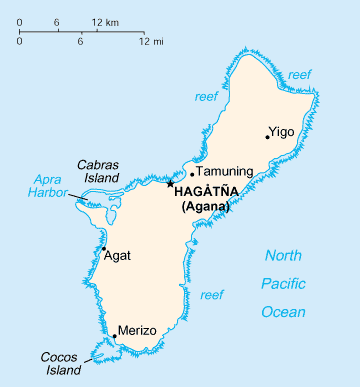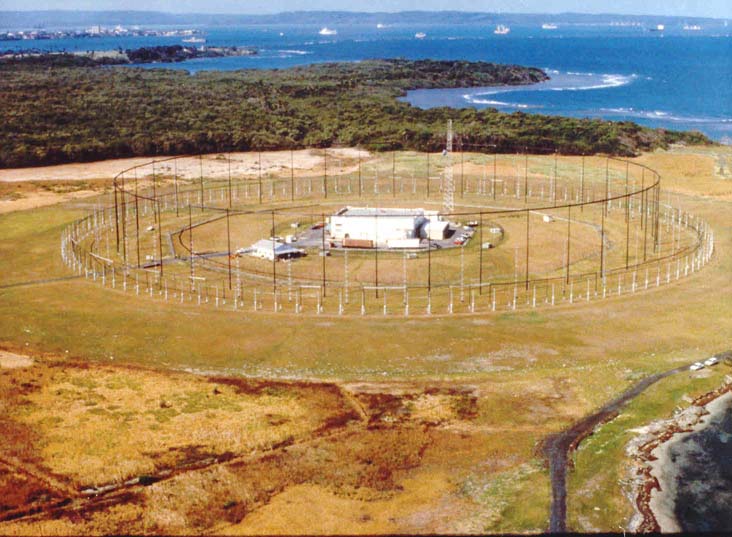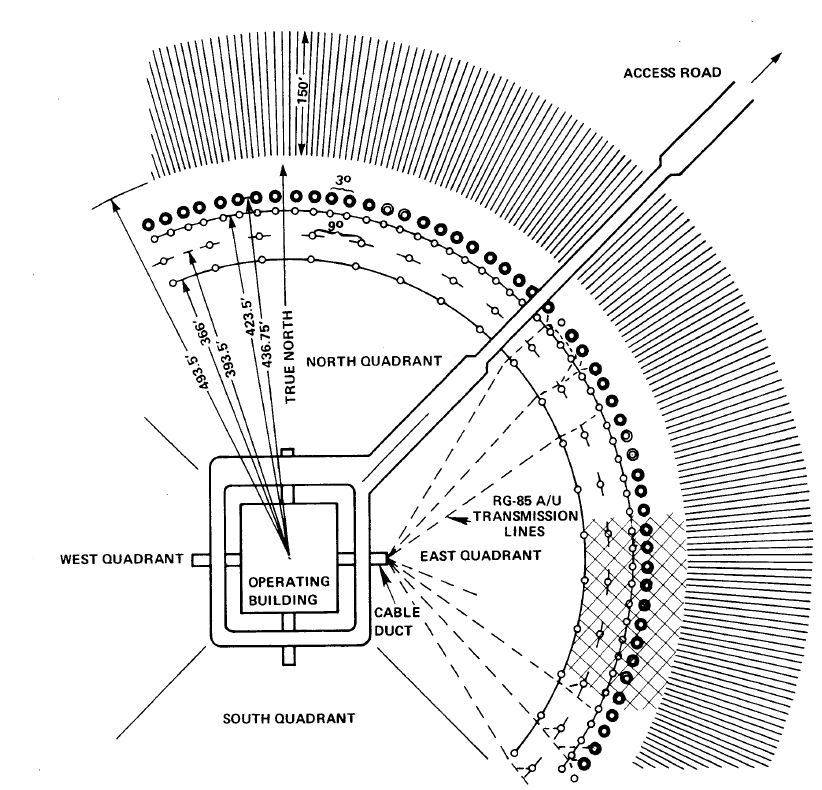|
Naval Computer And Telecommunications Station Guam
Naval Computer and Telecommunications Station Guam (NCTS Guam) is a United States Navy communications facility on the U.S. territory of Guam. It is located on the Naval Base Guam North Finegayan Telecommunications Site along Guam Highway 3 in Dededo, on the northwest coast of the island. NCTS Guam is under the United States Tenth Fleet's Naval Computer and Telecommunications Area Master Station Pacific (NCTAMS PAC) and under the installation management authority of Joint Region Marianas. It has been variously referred to as Naval Communications Station Guam (NCS Guam), NCS or NCTS Finegayan, and North Finegayan. NCTS Guam provides communications support in the areas of responsibility for the U.S. Third, Fifth, and Seventh Fleets. The facility dates back to 1944, immediately after the 1944 Battle of Guam. It was previously designated Naval Computer and Telecommunications Area Master Station Western Pacific (NCTAMS WESTPAC), before those responsibilities were merged with NCTAMS ... [...More Info...] [...Related Items...] OR: [Wikipedia] [Google] [Baidu] |
Tracking And Data Relay Satellite System
The U.S. Tracking and Data Relay Satellite System (TDRSS) is a network of American communications satellites (each called a tracking and data relay satellite, TDRS) and ground stations used by NASA for space communications. The system was designed to replace an existing network of ground stations that had supported all of NASA's crewed flight missions. The prime design goal was to increase the time spacecraft were in communication with the ground and improve the amount of data that could be transferred. Many Tracking and Data Relay Satellites were launched in the 1980s and 1990s with the Space Shuttle and made use of the Inertial Upper Stage, a two-stage solid rocket booster developed for the shuttle. Other TDRS were launched by Atlas IIa and Atlas V rockets. The most recent generation of satellites provides ground reception rates of 6 Mbit/s in the S-band and 800 Mbit/s in the Ku- and Ka-bands. This is mainly used by the United States military. Origins To satisfy ... [...More Info...] [...Related Items...] OR: [Wikipedia] [Google] [Baidu] |
Marine Corps Base Camp Blaz
Marine Corps Base (MCB) Camp Blaz is a U.S. Marine Corps facility located in the village of Dededo in northwest Guam. MCB Camp Blaz was activated on October 1, 2020, becoming the first new Marine Corps facility since the predecessor of Marine Corps Logistics Base Albany was commissioned on March 1, 1952. The base will house Marines relocated from installations in Okinawa Prefecture, Japan, with the final relocation planned for 2025. Joint Region Marianas is the installation management authority for MCB Camp Blaz, as well as Naval Base Guam and Andersen Air Force Base. MCB Camp Blaz is named after Brigadier General Vicente T. "Ben" Blaz. Blaz was the first person of an ethnic minority to reach general rank in the USMC and the highest ranking Chamorro ever, as well as Guam's delegate to Congress from 1985 to 1993. The main dormitories will be located next to Naval Computer and Telecommunications Station Guam, with the final base to house 1,300 permanently stationed Marines and ... [...More Info...] [...Related Items...] OR: [Wikipedia] [Google] [Baidu] |
Military Installations Of The United States In Guam
A military, also known collectively as armed forces, is a heavily armed, highly organized force primarily intended for warfare. It is typically authorized and maintained by a sovereign state, with its members identifiable by their distinct military uniform. It may consist of one or more military branches such as an army, navy, air force, space force, marines, or coast guard. The main task of the military is usually defined as defence of the state and its interests against external armed threats. In broad usage, the terms ''armed forces'' and ''military'' are often treated as synonymous, although in technical usage a distinction is sometimes made in which a country's armed forces may include both its military and other paramilitary forces. There are various forms of irregular military forces, not belonging to a recognized state; though they share many attributes with regular military forces, they are less often referred to as simply ''military''. A nation's military may f ... [...More Info...] [...Related Items...] OR: [Wikipedia] [Google] [Baidu] |
Communications And Electronic Installations Of The United States Navy
Communication (from la, communicare, meaning "to share" or "to be in relation with") is usually defined as the transmission of information. The term may also refer to the message communicated through such transmissions or the field of inquiry studying them. There are many disagreements about its precise definition. John Peters argues that the difficulty of defining communication emerges from the fact that communication is both a universal phenomenon and a specific discipline of institutional academic study. One definitional strategy involves limiting what can be included in the category of communication (for example, requiring a "conscious intent" to persuade). By this logic, one possible definition of communication is the act of developing meaning among entities or groups through the use of sufficiently mutually understood signs, symbols, and semiotic conventions. An important distinction is between verbal communication, which happens through the use of a language, and non ... [...More Info...] [...Related Items...] OR: [Wikipedia] [Google] [Baidu] |
Haputo Beach Site
The Haputo Beach Site is a prehistoric village site in northwestern Guam. The site, located on Naval Computer and Telecommunications Station Guam land near a sheltered cove, includes standing latte stones, as well as rock shelters and caves with evidence of human occupation. In addition to needing military permission for access to the site, the main trail leads through the Navy's Haputo Ecological Preserve. The site was listed on the National Register of Historic Places in 1974. See also *National Register of Historic Places listings in Guam __NOTOC__ This is a list of the buildings, sites, districts, and objects listed on the National Register of Historic Places in Guam. There are currently 134 listed sites spread across 17 of the 19 villages of Guam. The villages of Agana Heig ... References Archaeological sites on the National Register of Historic Places in Guam Dededo, Guam Beaches of Guam {{Oceania-archaeology-stub ... [...More Info...] [...Related Items...] OR: [Wikipedia] [Google] [Baidu] |
National Register Of Historic Places Listings In Guam
__NOTOC__ This is a list of the buildings, sites, districts, and objects listed on the National Register of Historic Places in Guam. There are currently 134 listed sites spread across 17 of the 19 villages of Guam. The villages of Agana Heights and Mongmong-Toto-Maite do not have any listings. __NOTOC__ Listed historic sites include Spanish colonial ruins, a few surviving pre-World War II ifil houses, Japanese fortifications, two massacre sites, and a historic district. Two other locations that were previously listed have been removed from the Register. Numbers of listings Agana Heights There are no properties listed on the National Register of Historic Places in Agana Heights. Asan-Maina Barrigada Chalan Pago-Ordot Dededo Hågat Hagåtña Former listings Humåtak Inalåhan Malesso Mangilao Mongmong-Toto-Maite There are no properties listed on the National Register ... [...More Info...] [...Related Items...] OR: [Wikipedia] [Google] [Baidu] |
Antenna (electronics)
In radio engineering, an antenna or aerial is the interface between radio waves propagating through space and electric currents moving in metal conductors, used with a transmitter or receiver. In transmission, a radio transmitter supplies an electric current to the antenna's terminals, and the antenna radiates the energy from the current as electromagnetic waves (radio waves). In reception, an antenna intercepts some of the power of a radio wave in order to produce an electric current at its terminals, that is applied to a receiver to be amplified. Antennas are essential components of all radio equipment. An antenna is an array of conductors ( elements), electrically connected to the receiver or transmitter. Antennas can be designed to transmit and receive radio waves in all horizontal directions equally (omnidirectional antennas), or preferentially in a particular direction ( directional, or high-gain, or “beam” antennas). An antenna may include components not connec ... [...More Info...] [...Related Items...] OR: [Wikipedia] [Google] [Baidu] |
Wullenweber
The Wullenweber (the original name introduced by Dr. Hans Rindfleisch was Wullenwever) is a type of Circularly Disposed Antenna Array (CDAA) sometimes referred to as a Circularly Disposed Dipole Array (CDDA). It is a large circular antenna array used for radio direction finding. It was used by the military to triangulate radio signals for radio navigation, intelligence gathering and search and rescue. Because its huge circular reflecting screen looks like a circular fence, the antenna has been colloquially referred to as the ''elephant cage.'' The term ''wullenwever'' was the World War II German cover term used to identify their secret CDAA research and development program; its name is unrelated to any person involved in the program. History Origin in World War II Germany Wullenweber technology was developed by the German navy communication research command, Nachrichtenmittelversuchskommando (NVK) and Telefunken during the early years of World War II. The inventor was NVK group ... [...More Info...] [...Related Items...] OR: [Wikipedia] [Google] [Baidu] |
AN/FRD-10
The AN/FRD-10 Circularly Disposed Antenna Array (CDAA) is a United States Navy circular "Wullenweber" antenna array, built at a number of locations during the cold war for high frequency radio direction finding (HF/DF) and signals intelligence. In the Joint Electronics Type Designation System, FRD stands for ''fixed ground, radio, direction'' finding. 14 sites were originally constructed as a part of the "Classic Bullseye" program. Two AN/FRD-10 systems were later installed in Canada. AN/FRD-10 systems were originally constructed in the early 1960s, but after the dissolution of the Soviet Union, the systems began to be shut down and demolished. The Naval Security Group operated and maintained the U.S. Navy AN/FRD-10 systems. The system had several nicknames including ''Fred-10'' and ''Elephant'' or ''Dinosaur cages''. As of 2015, none of the US Navy AN/FRD-10 sites are extant, but the two Canadian sites remain in service. The AN/FLR-9 was a system with a similar design and functi ... [...More Info...] [...Related Items...] OR: [Wikipedia] [Google] [Baidu] |
Cold War
The Cold War is a term commonly used to refer to a period of geopolitical tension between the United States and the Soviet Union and their respective allies, the Western Bloc and the Eastern Bloc. The term '' cold war'' is used because there was no large-scale fighting directly between the two superpowers, but they each supported major regional conflicts known as proxy wars. The conflict was based around the ideological and geopolitical struggle for global influence by these two superpowers, following their temporary alliance and victory against Nazi Germany and Imperial Japan in 1945. Aside from the nuclear arsenal development and conventional military deployment, the struggle for dominance was expressed via indirect means such as psychological warfare, propaganda campaigns, espionage, far-reaching embargoes, rivalry at sports events, and technological competitions such as the Space Race. The Western Bloc was led by the United States as well as a number of other First W ... [...More Info...] [...Related Items...] OR: [Wikipedia] [Google] [Baidu] |
Naval Communications Processing And Routing System
A navy, naval force, or maritime force is the branch of a nation's armed forces principally designated for naval warfare, naval and amphibious warfare; namely, lake-borne, riverine, littoral zone, littoral, or ocean-borne combat operations and related functions. It includes anything conducted by surface Naval ship, ships, amphibious warfare, amphibious ships, submarines, and seaborne naval aviation, aviation, as well as ancillary support, communications, training, and other fields. The strategic offensive role of a navy is Power projection, projection of force into areas beyond a country's shores (for example, to protect Sea lane, sea-lanes, deter or confront piracy, ferry troops, or attack other navies, ports, or shore installations). The strategic defensive purpose of a navy is to frustrate seaborne projection-of-force by enemies. The strategic task of the navy also may incorporate nuclear deterrence by use of submarine-launched ballistic missiles. Naval operations can be broa ... [...More Info...] [...Related Items...] OR: [Wikipedia] [Google] [Baidu] |
Naval Computer And Telecommunications Area Master Station Europe Central
A navy, naval force, or maritime force is the branch of a nation's armed forces principally designated for naval and amphibious warfare; namely, lake-borne, riverine, littoral, or ocean-borne combat operations and related functions. It includes anything conducted by surface ships, amphibious ships, submarines, and seaborne aviation, as well as ancillary support, communications, training, and other fields. The strategic offensive role of a navy is projection of force into areas beyond a country's shores (for example, to protect sea-lanes, deter or confront piracy, ferry troops, or attack other navies, ports, or shore installations). The strategic defensive purpose of a navy is to frustrate seaborne projection-of-force by enemies. The strategic task of the navy also may incorporate nuclear deterrence by use of submarine-launched ballistic missiles. Naval operations can be broadly divided between riverine and littoral applications (brown-water navy), open-ocean applications (blue- ... [...More Info...] [...Related Items...] OR: [Wikipedia] [Google] [Baidu] |





.png)

